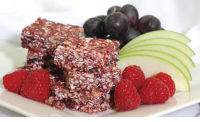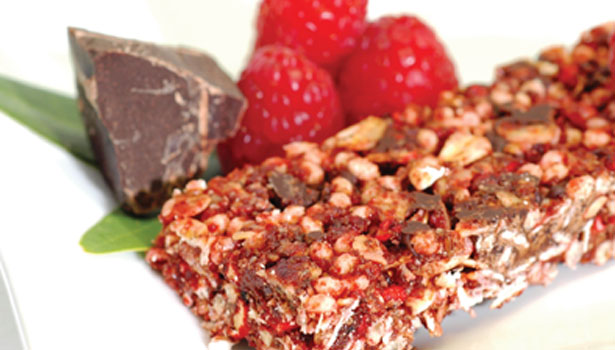Navigating Natural Flavorings
A little understanding behind the formulation and use of various flavoring systems is crucial to great-tasting food—and key to a successful product launch.

SOURCE: Culinex LLC

Vanilla contains at least several hundred chemical flavor compounds, most of them phenols, making it a superior enhancer as well as masker of off-notes.SOURCE:

Soy, fish, and mushroom sauces and concentrates, provide strong umami and kokami flavor notes. Fish concentrates, although having a very narrow range of applications, are excellent enhancers for seafood-based formulations. SOURCE: Culinex LLC

Baked goods and dairy products benefit from flavor maskers that can cover off-notes of such ingredients as leavenings or added proteins. SOURCE: Virginia Dare

By carefully layering flavor upon flavor and ensuring each complements and supports the others, it is possible to create the complexity of flavors that makes foods memorable.SOURCE: DSM Nutritionals Inc.

Many exotic fruits have subtle flavors that can easily be blown out in a formulation. Using concentrated extracts or natural enhancers can help bring their flavors to the foreground. SOURCE: Treatt Plc.






Keeping up with consumers’ burgeoning demand for authentically flavored foods created entirely from naturally derived ingredients is easier than ever, thanks to advances in all-natural flavoring systems. Food innovators can develop food products with on-trend flavor profiles and still keep the consumer’s demand for “all-natural” or “clean” labeling in check. However, the land of natural flavorings still poses challenges.
Depending on the category a product is developed to fit—dairy, bakery, snack, frozen—ingredients and techniques are determined by not only the desired flavor profiles, but by how the product will be manufactured, packaged, stored, prepared and consumed. This is because natural ingredients can sometimes—but not always—affect shelflife.
Potential challenges can arise when formulating with functional ingredients, certain high-intensity sweeteners or natural sodium reducers. These ingredi-ent categories can have triple impact. Some might pose barriers to a clean label; some replace ingredients that have natural preservative ef-fects, like salt or sugar; and some could alter flavor through interactions with other ingredients.
With the increased usage of vegetables in foods, innovations around savory/sweet flavor combinations will be heightened.
There continues to be a drive towards sugar reduction and increased healthy perception of foods and beverages. Innovations leading to reduced sugar, but desired sweetness perception, will be significant.
From the manufacturing angle, how and when heat will be applied (if at all) in processing can narrow ingredient choices. And, of course, it matters whether the main component is protein or starch. For beverages, whether the formulation is carbonated or still, dairy- or juice-based, also impacts ingredient choice. The answer to these questions helps the product developer create a road map for flavor explorations and expectations.
Thermal stability of natural flavors can be a challenge. For example, commercial UHT processing of foods and beverages can reach temperatures in excess of 300°F. This can necessitate significantly higher addition levels of flavorants, to offset potential degradation or offset the need to employ costly methods of aseptically adding the flavors, post-processing. There also is a definite lack of easy-to-use, post-
processing aseptic flavor-dosing systems.
Legal and Natural
The largest point of confusion in the natural foods realm is, “What is ‘natural’?” Consumers with an eye toward more healthful options, both for themselves and the planet, continue to push for improvements and variety in the natural market. Even after years of playing hot potato with the term, the FDA and USDA are hesitant to put strong descriptors around what “natural” and “all-natural” should mean.
While the FDA has disqualified most ingredients from being labeled as “natural” and specifies them as synthetic and/or artificial in the Code of Federal Regulations (CFR), it does allow one segment of ingredients to use the “natural” nomenclature: flavorings.
As stated in 21 CFR 101.22, a natural flavor is defined as “the essential oil, oleoresin, essence or extractive, protein hydrolysate, distillate, or any product of roasting, heating, enzymolysis, which [sic] contains the flavoring constituents derived from a spice, fruit or fruit juice, vegetable or vegetable juice, edible yeast, herb, bark, bud, root, leaf or similar plant material, meat, seafood, poultry, eggs, dairy products or fermentation products thereof whose significant function in food is flavoring rather than nutritional.”
As the explanation implies, natural flavorings take on a variety of forms. Thankfully, these forms are relatively easy to come by—if a flavor can be synthesized with artificial components, it can also be created using natural compounds rather than synthetic. However, flavor developers do run into a few problems when creating natural flavorings.
Developing natural flavors is more costly—usually 200-300% more than artificial flavors. Also, sourcing natural, high-performing flavor components can pose a problem. Where a synthetic compound might be available to carry a lemon top-note entirely through the processing of a baked lemon cookie, for example, developers might find it challenging to sustain that top-note without adding resinous or bitter off-notes. However, this type of flavor can be derived from a natural lemon oil or emulsion.
In addition to formulating from nature, flavor chemists also can take advantage of nutritional and food-safety aspects (including shelflife extension) that can sometimes be improved with natural flavorings. For example, certain rosemary extracts can act as both a flavorant and a powerful antimicrobial preservative.
Concentrated fruit juices, wine reductions and spice extracts bring with them the natural health benefits from their base compounds. Moreover, as with synthetic flavors, natural flavors are now of high enough chemical quality to provide consistent performance and strength from batch to production batch.
The Great Cover-up
As food processors geared up to meet the rising demand for healthful foods, the need arose for flavorings that can hide or alter off-notes, bitterness and astringency, and sour flavors. Such undesirable flavors often can be a part of functional ingredients, such as certain vitamins, minerals or other nutraceuticals. Moreover, sodium reduction or salt replacement, alternative sweeteners and protein isolates—especially soy protein—can add bitter or other undesirable notes. Enter flavorings with modifying properties—the so-called “FMP flavors.”
For pastries, baked goods and other sweet formulations, as well as for beverages and dairy, vanilla has long been used as both a flavor enhancer and a flavor masker. True, natural vanilla comes primarily from several main species of the vanilla orchid. It is derived through a cultivation/production method that is both complicated and costly.
Vanilla contains at least several hundred chemical flavor compounds, most of them phenols. While this combination gives vanilla its distinctive flavor, it also makes it extremely versatile as a masker and enhancer, since the various chemical compounds each react in unique ways with other flavors.
FMPs, or flavor maskers, have been widely used in the food industry to enhance, mask or modify a flavor. They are especially useful for balancing the flavors in fortified foodstuffs, such as meal replacement shakes, low-sodium and low-sugar foods. When developing specialized food products geared toward the health-conscience consumer, a developer will need to identify and alter any number of off-putting flavors.
Flavor modifiers are designed to be versatile and typically are provided as powders intended for blending into dry mixes, or as liquids for aqueous solutions. Flavor modifiers are needed only in minute quantities. Generally, they make up less than 0.2% of a formulation. Some are susceptible to extreme conditions of processing, such as very low pH or very high heat.
While FMPs should not contribute flavors of their own, they alter existing flavor profiles by changing flavor attributes. They can intensify specific flavors; hide bitter or off-flavor notes; or change the duration of flavor perception. Some are even crafted to delay the onset time of specific attributes of the flavor profile. An example would be to have a sweet flavor follow a sour one, and then fade to a subtle finish.
In the world of FMPs, ingredient makers continue to design new and creative natural innovations. They find ingredient inspiration in nature from such places as the African rainforest, the Amazon and other remote regions. They draw leads from folklore and anecdotal accounts of the botanicals unknown in the West.
One such discovery out of Africa is the fruit of the Thaumatococcus daniellii plant, nicknamed the “miracle berry” and particularly trendy of late. It has been used not only as a flavor masker for high-intensity sweeteners, but also as a general enhancer for savory and sweet applications.
Such botanical combinations are versatile, easy-to-use and come in a variety of forms—allowing food scientists and research chefs many options to fine-tune a flavor profile, so it delivers better taste while offering healthier food products.
Flavoring manufacturers also have been identifying a number of existing compounds that can block human taste receptors from bonding with bitter and off-flavor chemicals. By completely blocking the uptake of the negative chemicals, they reduce or eliminate any negative sensation for the consumer. With such new natural discoveries, FMP manufacturers have an array of options for the developer, narrowing solutions down by product category and production process.
Lock it In
Flavor encapsulation is also enjoying resurgence in popularity in the natural arena, due to its protective and masking qualities. Through spray drying or spray congealing, flavor chemists are able to create flavor systems that improve flavor impact, increase shelflife stability and improve heat and oxidative resistance. Spray congealing has the added benefit of providing mouthfeel to the final product.
A technique called “glass encapsulation” actually uses polyol or polysaccharide material as a secondary shell material to encapsulate spray-dried ingredients. It’s an ideal method for capturing lipid-based or other oil-soluble ingredients and allowing them to intersperse with water-based or dry systems. With glass encapsulation, developers can create products with long shelf lives (up to 24+ months), plus brighter flavor profiles. This is in addition to the other benefits of spray-dried or congealed encapsulation techniques.
Through the encapsulation process, bitter but beneficial foods and nutraceuticals can be added without adverse flavor affects. In the case of masking, microencapsulation is used to completely coat the offensive flavor. Green tea extract, for instance, can be completely coated, so its antioxidants are fully available, but the bitter/acrid flavor is undetectable by the consumer.
Enzyme-modified (EM) flavor refers to a method of creating cheese or other dairy flavors from the core ingredient. Such flavors are created by adding certain natural enzymes that break down major ingredient components and release the flavorants within. Lipases and other natural, food-grade enzymes are commonly used. EM has become a cost-effective method of providing intense cheese or dairy flavor without adding bulk or calories.
EM flavors also allow subtleties of authentic flavors, as they are derived from the unique cheese or dairy item. For example, EM flavors derived from a bleu cheese, a Cheddar or an artisanal sheep’s milk cheese each retain their identifying flavor profiles. They adapt readily to common processing systems, combining readily with other ingredients in the recipe matrix.
Giving a Boost
Salt has long been considered the original flavor enhancer. It can mellow harsher bitter notes, round out flavors and improve product quality and shelflife. But, with the intense pressure on processors to reduce sodium in their products, formulators for now are challenged to meet the demand without losing this elemental flavor component.
When creating clean label products, reaching for monosodium glutamate (MSG) is usually out of the question, as is hydrolyzed vegetable protein (HVP). Where FMPs work to cover up undesired flavors in natural and healthy food products, flavor enhancers step in to improve and elevate.
Typically high in glutamates, flavor enhancers partner with other flavor compounds to increase the sensation of umami, thus lowering the need for salt. Robustly flavored yeast extracts are good sources to enhance and round out flavors in reduced-sodium snack products, like crackers, nuts and chips. They also are favored for providing savory back-notes to soups, sauces, meats and vegetable products.
Created through a natural fermentation process, yeast extracts are concentrated into liquid, paste or powder formulations. These can then be combined with other flavor components or used alone to add richness, enhance sweetness and disguise off-notes. They are a fundamental provider of that vital umami component in many savory products.
Soy, fish and mushroom sauces and concentrates, too, provide strong umami (and sister kokami) flavor notes. Fish concentrates have a very narrow range of applications and can be high in sodium.
Until recently, soy sauces were not considered good substitutes for salt because of their high sodium content. However, recent technological developments have allowed for the creation of full-bodied, lower-sodium fermented soy extracts with complex, deep savory flavors.
Reducing salt also can affect the overall balance of flavors within a dish. A little pinch of salt can create harmony between a highly astringent or sour flavor, such as lemon juice, and a high-umami food like chicken. In these types of recipes, a reduction or base can step in where salt is unavailable to provide balance. Wine, liquor, spirit, stock and juice reductions can add complexity and richness to astringent, bitter or sour ingredients.
The attraction of these products is in their versatility of application. Incorporating them at the beginning of the production process will provide a backbone of flavor to the end-product. Added during cooking, they can help marry flavors and bring harmony to a recipe. If a long, lingering finish is desired, add these ingredients near the end of the cooking process.
If there is a downside to reductions, concentrates and bases, it might be that their concentrated forms can make them challenging to integrate into certain blends and mixes. This is easily fixed by reconstitution with some sort of dilution. This might also be necessary to fully disperse the flavor throughout the finished product.
A natural fruit juice concentrate, for example, will need a flavor system that won’t add acidity to a product that might be inherently acidic. In beverages, if the formulation will be heated before or during packaging, the flavor selection will need to stand up to the cooking process. Add shelf stability in a glass bottle to the equation, and the flavor needs to hold up over time, in an acidic environment with light filtering through the bottle. All of these are critical parameters that will affect the ultimate flavor experience.
Extract Science
Although the extraction of the core flavor components are sometimes achieved via chemical or other methods, natural extracts are commonly derived utilizing alcohol. (In some cases, extracts are merely flavor solutions mixed with ethyl alcohol and water.) When a true, natural extract is created, however, the components being extracted are “washed” in an alcohol-water solution.
While each manufacturer has its own method of extraction, the process typically includes combining botanical or essential oil with alcohol and water, allowing it to settle for an extended period of time—during which the alcohol, oil and water separate. As this process occurs, the essential oil releases its flavor to the alcohol and water, which is then siphoned off and filtered.
Beneficial in most applications, extracts are water-soluble, which allows easy incorporation with true, clean flavors. However, because they are alcohol-based, most extracts will lose potency once heated. Thus, pairing an extract with another flavoring component, like an oleoresin, ensures that top, middle and finishing notes are kept throughout cooking.
With that in mind, concentrated, alcohol-based natural flavors add both taste and fragrance, with high flavor intensity at low-dosage levels. When used properly within their recommended processing parameters, such concentrates are particularly useful in creating naturally flavored, clear beverages.
Essentials and Emulsions
While extracts are produced using alcohol, essential oils and oleoresins are oil-based, typically extracted through distillation or expression. Distillation requires steam or water, which slowly breaks down the flavorful material to remove its volatile constituents. The constituents rise up as vapor, which is captured by a condenser. The condenser cools and collects the water and oil. Because water and oil don’t mix, the oil can be easily collected from the top of the mixture.
Expression, also known as pressing, involves applying pressure to the substance to literally squeeze the oils out of it. Modern expression techniques sometimes involve ecuelle a piquer (literally “sting in a bowl”), a process by which the ingredient is poked or pricked to accelerate the process.
Modern expression techniques also are accomplished by using centrifugal force. The centrifuge separates the majority of essential oil from the other ingredient elements.
While naturally derived oils and oleoresins pack a lot of flavor, overuse can lead to bitterness and off-flavors in finished products. However, these ingredients pick up where extracts leave off in heated applications and can add the backbone to flavor systems. They’re especially favored in sauces and baked goods.
Emulsions are flavor extracts suspended in water, typically with a gum or starch. To create an emulsion, a flavor powder or oil is mixed with water and a stabilizer, and homogenized to create the suspension.
Water is a neutral carrier imparting no flavor of its own and does not evaporate as rapidly as alcohol when exposed to heat. This means better, more sustained flavor that will not bake out as easily as alcohol-based extracts. Because of this, emulsions are excellent choices for baking applications and most confections. However, their high water content makes them a poor choice to flavor trickier concoctions, like chocolate confections and hard candies.
The suspended quality of emulsions also makes them an excellent choice in beverage applications, as they not only flavor, but also can add texture and body to the finished product. However, most emulsions have color and opacity, making them rarely suited for clear beverage applications.
When using flavors, start with the end in mind and consider various products to build layers of flavor. Take flavor-building cues from inspirations such as restaurants or the home kitchen. In food product development, flavor is king. Navigating the flavor landscape can be tricky, but natural flavors can be the key to hitting the flavor bulls-eye. Partnering with flavor experts will streamline the creation process for developers, allowing them to find the right natural flavor for an application.
The future of natural flavors will certainly be a collaborative affair, as food and beverage companies form partnerships with innovative flavor houses to co-process high-value natural flavors and provide novel solutions for customers.
Looking for a reprint of this article?
From high-res PDFs to custom plaques, order your copy today!













